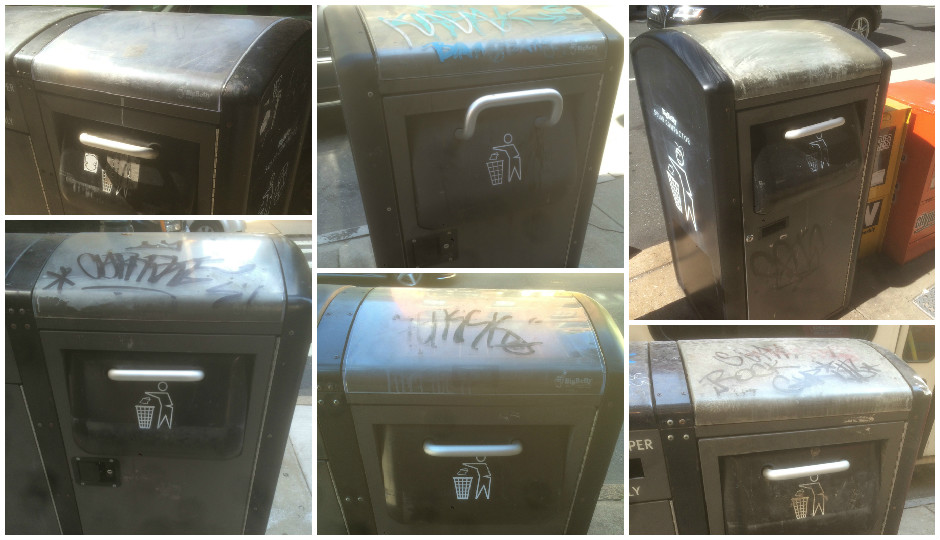The Sorry State of Philadelphia’s Big Belly Trash Cans

A sampling of the condition of some Center City Big Belly trash cans. | Photos by Tom Beck.
Philadelphia has a love-hate relationship with its Big Belly trashcans, those solar-powered trash compactors with handles so foul, most of us open them with our elbows — or not at all.
On the one hand, they’re clearly superior to the old wire mesh models, which overflowed faster than the Streets Department emptied them. The city says the Big Belly cans save them about $1 million a year in collection costs, because sanitation workers don’t have to swing by as often to collect the trash, given the compacting-function. And it was nice for a while there that Philadelphia was leading the way on a new urban innovation (the city was the among first in the U.S. to deploy solar-powered public trash cans at scale).
But the gee-whiz novelty wore off pretty quickly, given the ick factor of those handles. And a lot of the older Big Bellies are really showing their age. A quick tour of Center City big bellies found many covered in graffiti and general grime.
So perhaps it’s not surprising that the trash cans appear to be wearing on the nerves of Paul Levy, the executive director of Center City District, who looks at downtown from a perspective that is equal parts Robert Moses and Martha Stewart.
In the latest edition of CCD’s quarterly newsletter, the business improvement district laments the city’s lack of a dedicated cleaning budget for the Big Belly trash cans. Back when the trash cans were first deployed — after a joint CCD and city month-long demonstration project — the district advised the city to budget $20 per year per can for cleaning and to spend $42.50 upfront for each receptacle to treat them with an anti-graffiti film. “The Streets Department chose not to provide for those services after the full deployment was made,” reads the newsletter.
Shots fired! In newsletter-speak, anyway.
But that’s not how the city remembers it, says Nutter administration spokesman Mark McDonald. “Streets tells me they are unaware than an anti-graffiti film coating was proposed,” he writes in an email. As for the department’s Big Belly cleaning regimen, McDonald says “the Department does a deep cleaning at the beginning of each Spring and each Fall, and staff also cleans on an as-needed basis throughout the year.”
Whatever the cleaning schedule is, it pretty clearly hasn’t been robust enough to keep the trash cans looking all that good.
How much does any of this matter? Both not at all, and more than you’d think. Obviously, in the context of all that ails Philadelphia, Big Belly trash cans do not rank. At all. But… a vibrant Center City is an essential component of a healthy and prosperous Philadelphia, and the improving public environment of Center City is clearly one of the factors responsible for downtown’s recent growth.
Major projects like Dilworth Plaza and Sister Cities park rightly get the headlines, but the little stuff shapes our perceptions — and that of tourists — as well. How clean are the sidewalks? How clear is the street signage? How effective is the lighting?
Those are the sorts of questions the Center City District wants the next mayor to be thinking about. In this edition of its newsletter, the district laments the prevalence of graffiti, rogue newspaper honor boxes, shabby building facades, poorly maintained parking signs and kiosks and overflowing dumpsters as some of the “streetscape features with the most problems.” Taking care of those admittedly small-bore issues would, Levy argues, “help take the public environment of Center City to the next level.”
And don’t forget the Big Belly trash cans, which started out as a clear enhancements to the public environment, but are now probably at best neutral features. The good news? New Big Belly trash cans are coming … slowly. And these ones are going to have foot pedals.